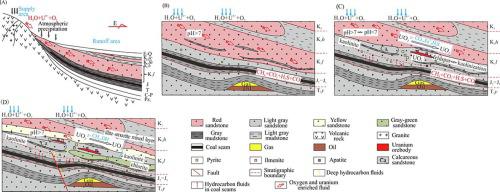Ore Geology Reviews ( IF 3.3 ) Pub Date : 2021-09-20 , DOI: 10.1016/j.oregeorev.2021.104486 Qiang Zhu 1, 2, 3 , Jianguo Li 2, 4 , Sibo Wen 1, 2, 3 , Guangyao Li 1, 2, 3 , Rengan Yu 1, 2, 3 , Peisen Miao 1, 2, 3 , Bo Zhang 1, 2, 3

|
To ascertain the characteristics of mineral assemblages associated with uranium mineralization and enrichment mechanism of deep sandstone-type uranium deposits, drill-core logging, petrography and mineralogy, scanning electron microscopy (SEM), electronic probe micro analysis (EPMA), whole-rock analysis, X-ray diffraction (XRD) were used to identify the types, redox state of uranium minerals, and typical uranium-related mineral assemblages in the sandstone of the Cretaceous Luohe Formation, southwestern Ordos Basin. The results showed that the clastic grains in the gray and red uranium-bearing sandstone have undergone relatively strong alteration, while alteration of the clastic grains in the gray and red calcareous sandstone is relatively weak. The alteration minerals mainly include pyrite, anatase, kaolinite, chlorite, calcite, apatite, and feldspar. Uranium contents is highly consistent with S, P2O5, CaO, and FeO concentrations in the vertical direction and has a weak correlation with the total organic carbon. Uranium ores are mainly pitchblende and titanium-bearing uranium minerals. The Luohe Formation experienced transformation from a weak alkaline oxidation environment during the diagenetic stage to a weak acid reduction conditions in the early mineralization stage and then to a weak alkaline reduction environment in the middle–late mineralization stages. Typical alteration minerals associated with uranium ores include two types, which are formed in acid reduction and alkaline reduction redox stages, respectively. The alteration minerals related to acidic fluid process are pyrite, anatase, kaolinite, and apatite; those related to alkaline fluid mechanism consist of calcite and chlorite. Deep-seated uranium mineralization was formed by both acidic and alkaline reducing fluids, being dominated by acidic fluid conditions. In-depth investigation of the alteration and uranium ore minerals are of great scientific value to infer the fluid type of mineralization stage and reveal the enrichment mechanism of uranium deposits.
中文翻译:

鄂尔多斯盆地西南部白垩系漯河组铀赋存状态及富集机制
确定与深砂岩型铀矿床的铀成矿和富集机制相关的矿物组合特征、钻芯测井、岩相和矿物学、扫描电镜(SEM)、电子探针显微分析(EPMA)、全岩分析,利用X射线衍射(XRD)对鄂尔多斯盆地西南部白垩系漯河组砂岩中铀矿物的类型、氧化还原状态和典型的铀相关矿物组合进行鉴定。结果表明,灰红色含铀砂岩中碎屑颗粒蚀变较强烈,而灰红色钙质砂岩中碎屑颗粒蚀变较弱。蚀变矿物主要有黄铁矿、锐钛矿、高岭石、绿泥石、方解石、磷灰石、和长石。铀含量与S、P高度一致2 O 5、CaO 和 FeO 浓度在垂直方向上,与总有机碳的相关性较弱。铀矿主要是沥青铀矿和含钛铀矿。漯河组经历了由成岩阶段的弱碱性氧化环境向矿化早期的弱酸性还原环境转变,再到矿化中后期的弱碱性还原环境。典型的铀矿伴生蚀变矿物有两种,分别在酸还原和碱还原氧化还原阶段形成。与酸性流体过程有关的蚀变矿物有黄铁矿、锐钛矿、高岭石和磷灰石;与碱性流体机理有关的那些由方解石和绿泥石组成。深部铀矿化由酸性和碱性还原流体形成,以酸性流体条件为主。深入研究蚀变和铀矿矿物对推断成矿阶段的流体类型和揭示铀矿床的富集机制具有重要的科学价值。


























 京公网安备 11010802027423号
京公网安备 11010802027423号